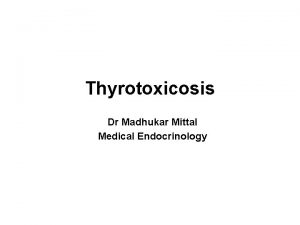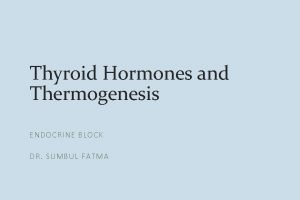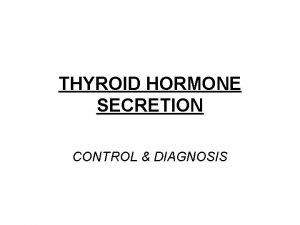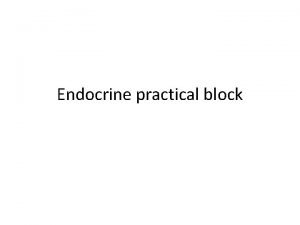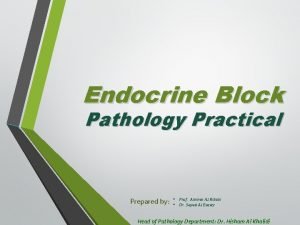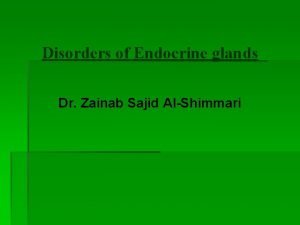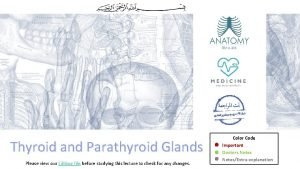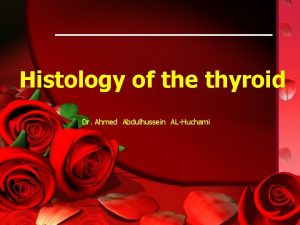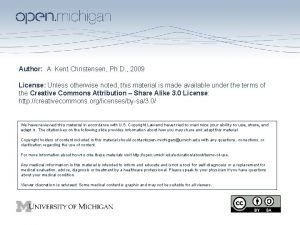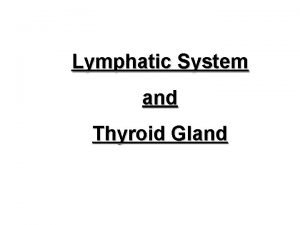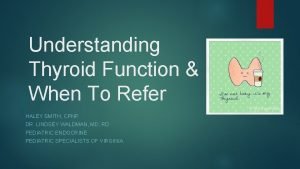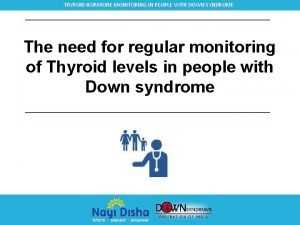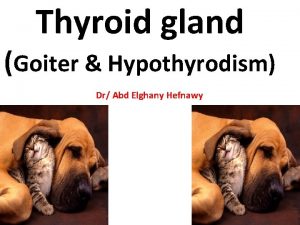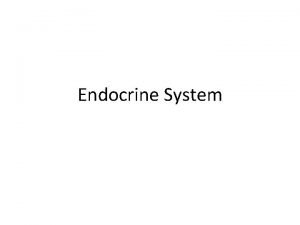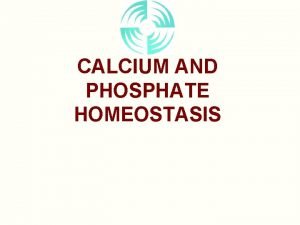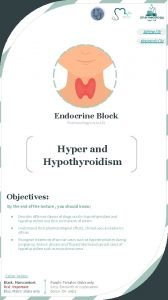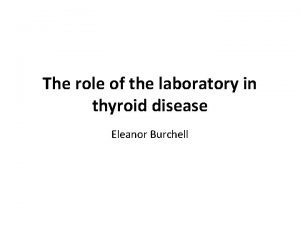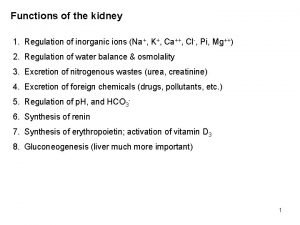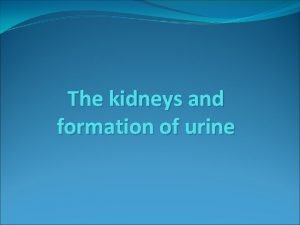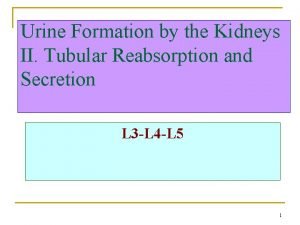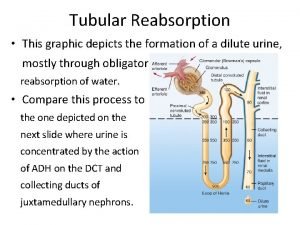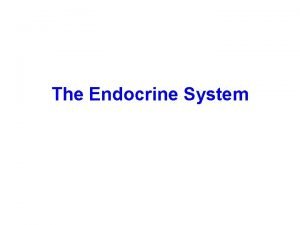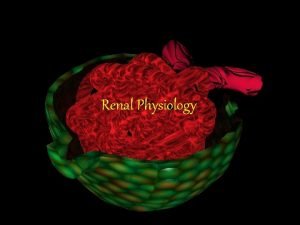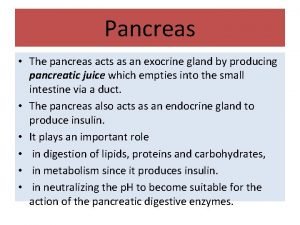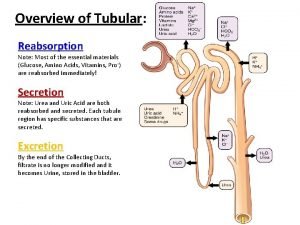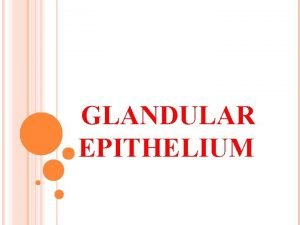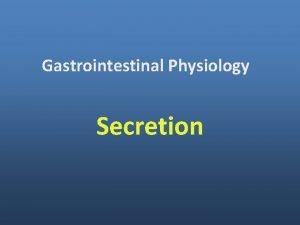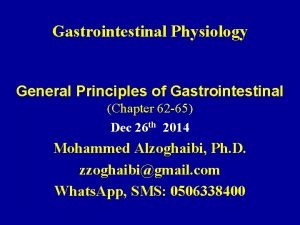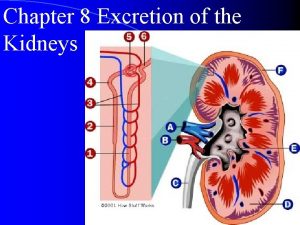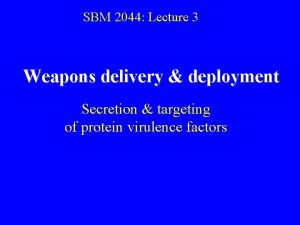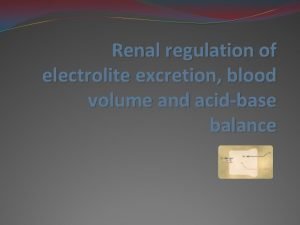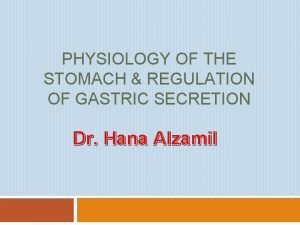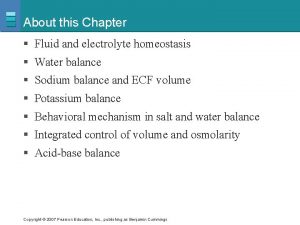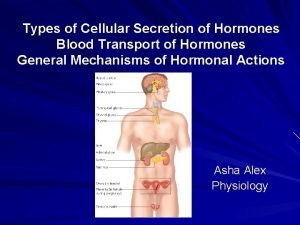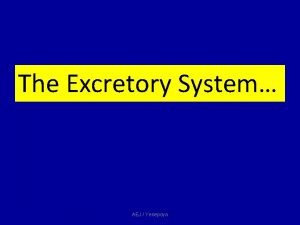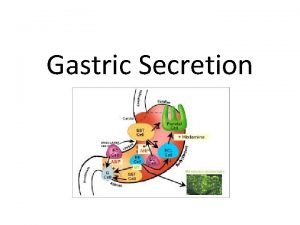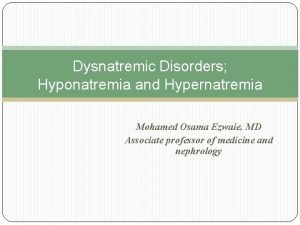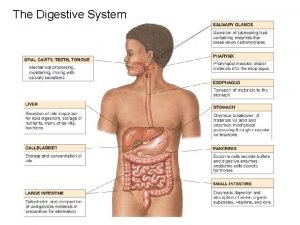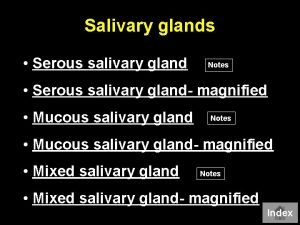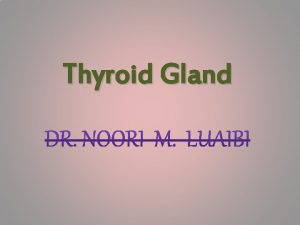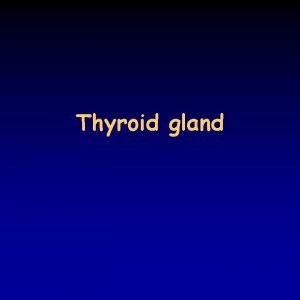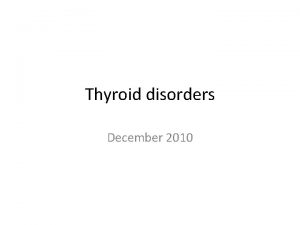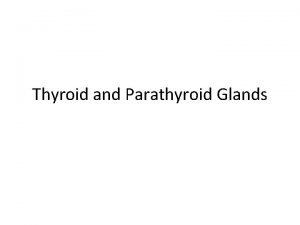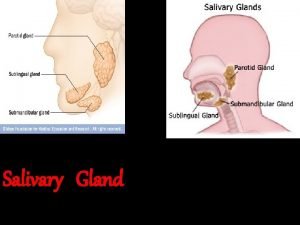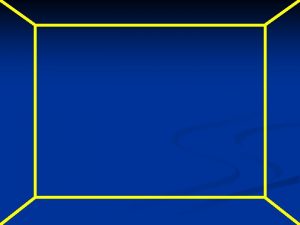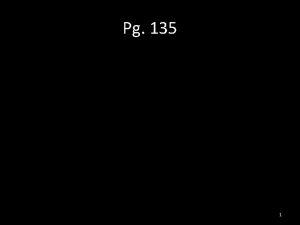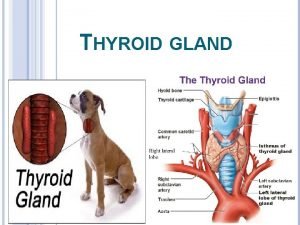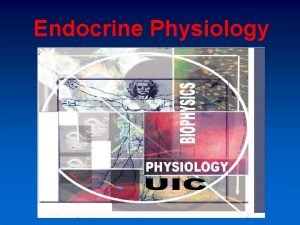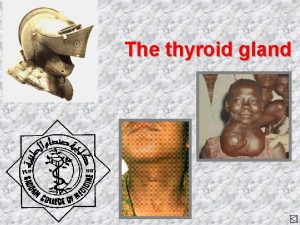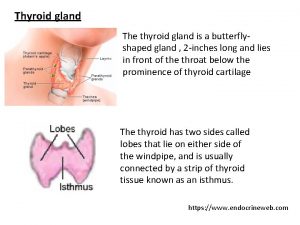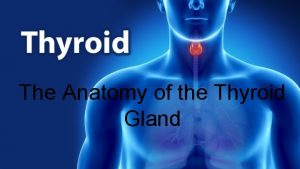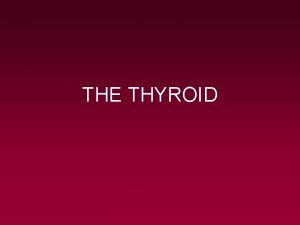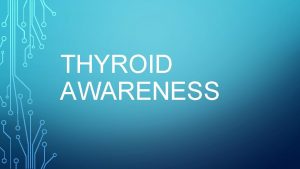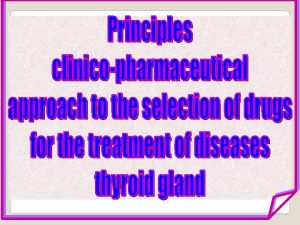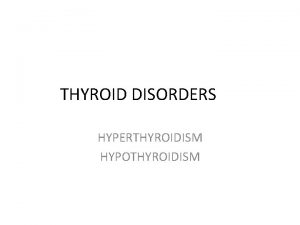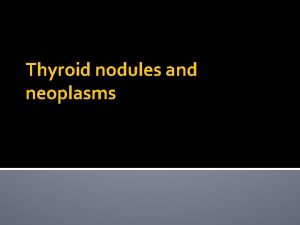Thyroid gland diseases Dr Isazadehfar Synthesis and Secretion


















































- Slides: 50

Thyroid gland diseases Dr. Isazadehfar


Synthesis and Secretion o Follicular cells arranged in clumps o Clumps of cells contain colloid o Colloid an iodine containing protein called thryoglobulin. This is the precursor and storage form of thyroid hormone o Thyroxine (T 4), Triiodothyronone (T 3)

Thyroid hormone action o T 4 and T 3 circulate in the blood bound to plasma proteins. o TBG(70%), TBPA(20%) and albumin(10%). o T 3 is the active form, 5 times more active than T 4. o T 4 is converted to T 3 outside thyroid, mostly in liver and kidney. o T 3 binds to a nuclear receptor

Regulation of the H-P-T axis o TRH secreted from hypothalamus controls TSH production. o TSH from anterior pituitary stimulates secretion of T 4 and T 3 from thyroid o Regulated by a negative feedback loop

Hypothyroidism

Prevalence of Hypothyroidism o Prevalence is 14/1000 females and 1/1000 males o Other autoimmune diseases o Family history of autoimmune diseases

Primary hypothyroidism-Causes o Autoimmune thyroiditis (Hashimoto’s)(most common in adults) o Radioactive iodine o Post thyroidectomy o Anti-thyroid drugs (CMZ PTU) o Lithium - Amioderone o Iodine deficiency o Subacute thyroiditis o Infiltrative disease o Agenesis

Secondary hypothyroidism-causes o Hypothalamic disease o Pituitary disease

Clinical features General and CVS o o o Tiredness Weight gain Cold intolerance Goitre Constipation Hair loss o o o Bradycardia Angina Cardiac Failure Pericardial effusion Hypothermia

Clinical Features Neurological and Haematological o o o o Aches and Pains Carpal Tunnel Deafness Hoarseness Ataxia Depression Psychosis o Iron deficiency A o Pernicious Anemia

Clinical Features Skin and Reproduction o Dry skin o Erythema o Vitiligo o o Infertility Menorrhagia Galactorrhoea Amenorrhea

Laboratory Diagnosis o o o T 4/FT 4 reduced T 3/FT 3 reduced TSH elevated Thyroid Antibodies may indicate aetiology If TSH is reduced or normal in the presence of a low T 4, pituitary function necessary

Additional abnormal tests o Fasting cholesterol and triglycerides may be raised o AST and LDH may be raised o CK , Chol , Triglyceride o Normochromic or macrocytic anemia o ECG: Bradycardia with small QRS complexes

Treatment o Levothyroxine n If no residual thyroid function 1. 5 μg/kg/day n Patients under age 60, without cardiac disease can be started on 50 – 100 μg/day. Dose adjusted according to TSH levels n In elderly especially those with CAD the starting dose should be much less 12. 5 – 25 μg/day o Compliance and adequacy of dose checked by TSH measurements o Try to maintain TSH in normal range


Subclinical Hypothyroidism o Primary thyroidal failure (Hashimotos) is a gradual process o Non specific symptoms o Reduced thyroid activity has been compensated by an increase TSH output to maintain a euthyroid state o Normal T 4/FT 4 with elevated TSH o Thyroid antibodies usually positive

Treatment o Repeat tests after an interval o If TSH is continuing to rise in the presence of strongly positive antibodies, the risk of developing hypothyroidism in the future is high. Thus treatment with thyroxin at this early stage may be justified if symptomatic o Beware: Thyroxine may not cure all symptoms

Myxoedema Coma o o o o Requires prompt treatment. Mortality of 50%. Suspect in cases of hypothermia T 3 20μg bid IM Steroids recommended Glucose to correct hypoglycaemia Rewarming Assisted ventilation

Thyroid hormone deficiency in Pregnancy o Goitre is common in pregnant women o TBG increased, thus total T 4 and T 3 increased. FT 4 and FT 3 are normal and TSH remains unchanged. o Hypothyroidism treated with thyroxin during pregnancy. Dose requirements increase. A change in dose usually needed each trimester.

Post-partum thyroiditis o Incidence is about 9%. o Transitory or permanent o Early hyperthyroidism , later hypothyroidism , euthyroid later. o Increased microsomal antibodies. o Thyroxine

Elderly o o o Non specific symptoms Osteoporosis Anemia Heart Failure Treatment with thyroxine Start with small doses and titrate slowly. (25μg).

Summary o o o Suspicion Women Previous thyroid disease or treatment Other autoimmune diseases Elderly- caution with treatment

HYPERTHYROIDISM Prevalence Women 2% Men 0. 2% 15% of cases occur in patients older than 60 years of age

Mechanism of Clinical Symptoms 1. Catabolism 2. Enhancement of sensitivity to catecholamines

Hyperthyroidism Symptoms o o o o Hyperactivity/ irritability/ dysphoria Heat intolerance and sweating Palpitations Fatigue and weakness Weight loss with increase of appetite Diarrhoea Polyuria Oligomenorrhoea, loss of libido

Hyperthyroidism Signs o o o o Tachycardia (AF) Tremor Goiter Warm moist skin Proximal muscle weakness Lid retraction or lag Gynecomastia

Causes of Hyperthyroidism Most common causes n Graves disease n Toxic multinodular goiter n Autonomously functioning nodule Rarer causes n Thyroiditis or other causes of destruction n Thyrotoxicosis factitia n Iodine excess (Jod-Basedow phenomenon) n Struma ovarii n Secondary causes (TSH or ßHCG)

Graves Disease o Autoimmune disorder o Abs directed against TSH receptor with intrinsic activity. Thyroid and fibroblasts o Responsible for 60 -80% of Thyrotoxicosis o More common in women

Graves Disease Eye Signs N - No signs or symptoms O – Only signs (lid retraction or lag) no symptoms S – Soft tissue involvement (periorbital oedema) P – Proptosis (>22 mm)(Hertl’s test) E – Extra ocular muscle involvement (diplopia) C – Corneal involvement (keratitis) S – Sight loss (compression of the optic nerve)

Graves Disease Other Manifestations o o Pretibial mixoedema Thyroid acropachy Onycholysis Thyroid enlargement with a bruit frequently audible over the thyroid

Onycholysis : softening of nails and loosening of nail beds o Low total cholesterol o Low HDL o Low total cholesterol/HDL ratio

Diagnosis of Graves Disease o TSH , free T 4 o Thyroid auto antibodies o Nuclear thyroid scintigraphy (I 123, Te 99)

Treatment of Graves Disease o Reduce thyroid hormone production or reduce the amount of thyroid tissue n Antithyroid drugs: propyl-thiouracil, carbimazole n Radioiodine n Subtotal thyroidectomy → relapse 4 -6 W after antithyroid therapy(euthyroid), pregnancy, young people? o Smptomatic treatment n Propranolol

Neoplastic Thyroid Disease o Thyroid Nodules o Goiter n Multinodular n Diffuse n Endemic o Thyroid Cancer n Well differentiated and poorly differentiated

Thyroid Nodular Disease o Thyroid gland nodules are common in the general population o Mainly in women o Most thyroid nodules are benign n Less than 5% are malignant n Only 8% to 10% of patients with thyroid nodules have thyroid cancer

Multinodular Goiter (MNG) o MNG is an enlarged thyroid gland containing multiple nodules n The thyroid gland becomes more nodular with increasing age n In MNG, nodules typically vary in size n Most MNGs are asymptomatic o MNG may be toxic or nontoxic n Toxic MNG occurs when multiple sites of autonomous nodule hyperfunction develop, resulting in thyrotoxicosis n Toxic MNG is more common in the elderly

Endemic Goiter o No longer a problem in the developed world o Still a serious health concern in parts of the world with iodine deficiency including mountainous areas or areas with high rainfall/flooding Kaplan, E. et al. Thyroid Disease Manager “Surgery of the Thyroid Gland” Chapter 21, May 9

Thyroid Carcinoma o Incidence n Thyroid carcinoma occurs relatively infrequently compared to the common occurrence of benign thyroid disease o Thyroid carcinomas n Papillary (70%) n Follicular (15%) n Medullary thyroid (5%) n Anaplastic carcinoma (5%) n Primary thyroid lymphomas (5%) n Metastatic from other primary sites (rare)

Risk factors for Malignancy o Solitary thyroid nodules in patients >60 or <30 years of age o Irradiation of the neck or face during infancy or teenage years o Symptoms of pain or pressure (especially a change in voice) o Male sex o Large Nodules (>3 or 4 cm) o Growth of nodule

Evaluating Thyroid Nodules o o TSH measurement Ultrasound of the thyroid Fine needle aspiration Radioactive iodine imaging

Thyroid Ultrasonography o Excellent for characterizing size and other features of nodule o Useful in localizing nodule for FNA o Cannot distinguish between benign vs. malignant

Thyroid FNA o Now considered the most cost effective and sensitive/specific diagnostic test of thyroid nodules o The use of US has expanded the role of FNA in evaluating nodules and improved the validity of the results

Typical Presentation of Thyroid Cancer o Painless lump o Normal thyroid function tests o Found on routine examination or by the patient o Slow growth or no growth over several months

Types of Thyroid Cancer o Papillary : develops from thyroid follicle cells in 1 or both lobes; grows slowly but can spread o Follicular : common in countries with insufficient iodine consumption; lymph node metastases are uncommon o Medullary: develops from C-cells, can spread quickly; sporadic and familial types o Anaplastic: develops from existing papillary or follicular cancers; aggressive, usually fatal o Lymphoma: develops from lymphocytes; uncommon

Papillary Thyroid Cancer o Most common type o Makes up about 70% of all thyroid carcinomas o Females outnumber males 3: 1 n Highest incidence in women in midlife

Papillary Thyroid Cancer Characteristics o Unencapsulated tumor nodule with ill-defined margins o Tumor typically firm and solid o May present as nodal enlargement o Commonly metastasizes to neck and mediastinal lymph nodes n 40% to 60% in adults and 90% in children o <5% of patients have distant metastases at time of diagnosis n Lung is most common site

Follicular Thyroid Cancer o Second most common type of thyroid cancer o Solid invasive tumors, usually solitary and encapsulated o Usually stays in the thyroid gland, but can spread to the bones, lungs, and central nervous system o Usually does not spread to the lymph nodes Follicular Thyroid Cancer.

Medullary Thyroid Cancer o Tumor arising from the calcitonin-secreting C-cells of the thyroid gland o Mortality rate of 10% to 20% at 10 years o 20% to 30% are part of 3 familial autosomal dominant syndromes (MEN -2 A, MEN-2 B, or familial non-MEN medullary thyroid cancer [median age=21 years]) Medullary (C-cell) Carcinoma

Treatment of Thyroid Cancer Summary o Papillary and follicular thyroid cancer n Generally excellent prognosis n Risk for recurrence for as long as 30 years o Initial management n Surgery and radioactive iodine n LT 4 suppressive therapy o Follow-up n n Physical examination Radioactive iodine scans Serum Tg TSH and T 4
 Dr madhukar mittal
Dr madhukar mittal Thyroid hormone secretion
Thyroid hormone secretion Erythropin
Erythropin Pituitary gland and pineal gland spiritual
Pituitary gland and pineal gland spiritual Pheochromocytoma
Pheochromocytoma Enlarged thyroid gland
Enlarged thyroid gland Enlarged thyroid gland
Enlarged thyroid gland Thyroid and parathyroid glands
Thyroid and parathyroid glands Thyroid class 11
Thyroid class 11 Principal cells location
Principal cells location Follicular cells of thyroid gland
Follicular cells of thyroid gland Parafollicular cells vs follicular cells
Parafollicular cells vs follicular cells Physiology of thyroid gland
Physiology of thyroid gland Parathyroid gland chief cell
Parathyroid gland chief cell Is thyroid a lymphatic organ
Is thyroid a lymphatic organ Histology thyroid gland
Histology thyroid gland Hashitoxicosis
Hashitoxicosis How to check thyroid at home
How to check thyroid at home Hyperparathyrodism
Hyperparathyrodism Types of thyroid
Types of thyroid Four oval masses on posterior thyroid gland
Four oval masses on posterior thyroid gland Pineal gland pituitary gland
Pineal gland pituitary gland Thyrotoxicosis mnemonic
Thyrotoxicosis mnemonic Wolff chaikoff effect
Wolff chaikoff effect Reabsorption
Reabsorption Tubular reabsorption and secretion
Tubular reabsorption and secretion Urine formation introduction
Urine formation introduction Sodium reabsorption
Sodium reabsorption Renal reabsorption
Renal reabsorption Loop of henle
Loop of henle Msh secretion
Msh secretion Where does secretion occur in nephron
Where does secretion occur in nephron Pancreatic juice
Pancreatic juice Tubular secretion in nephron
Tubular secretion in nephron Merocrine glands
Merocrine glands Gastric secretion
Gastric secretion Secretion of bicarbonate ions
Secretion of bicarbonate ions Hydrogen secretion in kidney
Hydrogen secretion in kidney Merocrine gland
Merocrine gland Type 3 secretion system
Type 3 secretion system Type 3 secretion system
Type 3 secretion system H+ secretion in proximal tubule
H+ secretion in proximal tubule Function of stomach
Function of stomach H+ secretion in proximal tubule
H+ secretion in proximal tubule Types of hormone secretion
Types of hormone secretion Osmoaia
Osmoaia Contents of gastric juice
Contents of gastric juice Sodium deficit correction formula
Sodium deficit correction formula Secretion of gastric juice
Secretion of gastric juice Secretion of gastric juice
Secretion of gastric juice Duct and gland difference
Duct and gland difference
